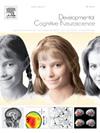Neural network topology in children’s deceptive behaviors: The role of cognitive control and reward processing
IF 4.9
2区 医学
Q1 NEUROSCIENCES
引用次数: 0
Abstract
The neural mechanisms related to children’s deceptive behaviors remain relatively unexplored. This study aims to address this gap by using measures of functional brain network topology, focusing on the cognitive control and reward processing networks that are closely related to children’s deceptive behaviors. The study included 113 6-year-old children from the Growing Up in Singapore Towards Healthy Outcomes (GUSTO) project, a birth cohort study. Children participated in the Dart Game designed to assess their tendencies to cheat and lie. During the game, children were required to throw the ball at a long-distance dartboard without supervision, which provided opportunities to cheat by breaking the rules. After the game, children were questioned about whether they had followed the rule, which provided them with opportunities to lie. Resting-state functional magnetic resonance imaging (rs-fMRI) data were collected from all children at the same age during a different visit. We compared three network topology measures (cognitive control network recruitment, reward processing network recruitment and reward-control network integration) between non-cheaters and cheaters, as well as between non-liars and liars. The results showed that a higher degree of cognitive control network recruitment was associated with a greater likelihood of lying. Moreover, a higher degree of reward-cognitive control network integration was associated with a lower likelihood of cheating and lying. The degree of reward processing network recruitment was not associated with deceptive behaviors. These findings help to elucidate how neural mechanisms of cognitive control and reward processing contribute to deceptive behaviors in young children.
神经网络拓扑在儿童欺骗行为中的作用:认知控制和奖励加工的作用
与儿童欺骗行为相关的神经机制尚未得到充分的研究。本研究旨在通过功能脑网络拓扑测量来解决这一空白,重点关注与儿童欺骗行为密切相关的认知控制和奖励处理网络。该研究包括113名来自新加坡健康成长项目(GUSTO)的16岁儿童,这是一项出生队列研究。孩子们参加了旨在评估他们欺骗和撒谎倾向的飞镖游戏。在游戏中,孩子们被要求在没有监督的情况下将球扔向一个远距离的飞镖靶,这就为违反规则作弊提供了机会。游戏结束后,孩子们被问及他们是否遵守了规则,这给了他们撒谎的机会。静息状态功能磁共振成像(rs-fMRI)数据收集自同一年龄的所有儿童在不同的访问期间。我们比较了三种网络拓扑测量(认知控制网络招募、奖励处理网络招募和奖励-控制网络整合)在非撒谎者和撒谎者之间,以及在非撒谎者和撒谎者之间。结果表明,认知控制网络的激活程度越高,说谎的可能性越大。此外,较高程度的奖励-认知控制网络整合与较低的作弊和说谎可能性相关。奖励处理网络招募的程度与欺骗行为无关。这些发现有助于阐明认知控制和奖励加工的神经机制如何影响幼儿的欺骗行为。
本文章由计算机程序翻译,如有差异,请以英文原文为准。
求助全文
约1分钟内获得全文
求助全文
来源期刊

Developmental Cognitive Neuroscience
NEUROSCIENCES-
CiteScore
7.60
自引率
10.60%
发文量
124
审稿时长
6-12 weeks
期刊介绍:
The journal publishes theoretical and research papers on cognitive brain development, from infancy through childhood and adolescence and into adulthood. It covers neurocognitive development and neurocognitive processing in both typical and atypical development, including social and affective aspects. Appropriate methodologies for the journal include, but are not limited to, functional neuroimaging (fMRI and MEG), electrophysiology (EEG and ERP), NIRS and transcranial magnetic stimulation, as well as other basic neuroscience approaches using cellular and animal models that directly address cognitive brain development, patient studies, case studies, post-mortem studies and pharmacological studies.
 求助内容:
求助内容: 应助结果提醒方式:
应助结果提醒方式:


